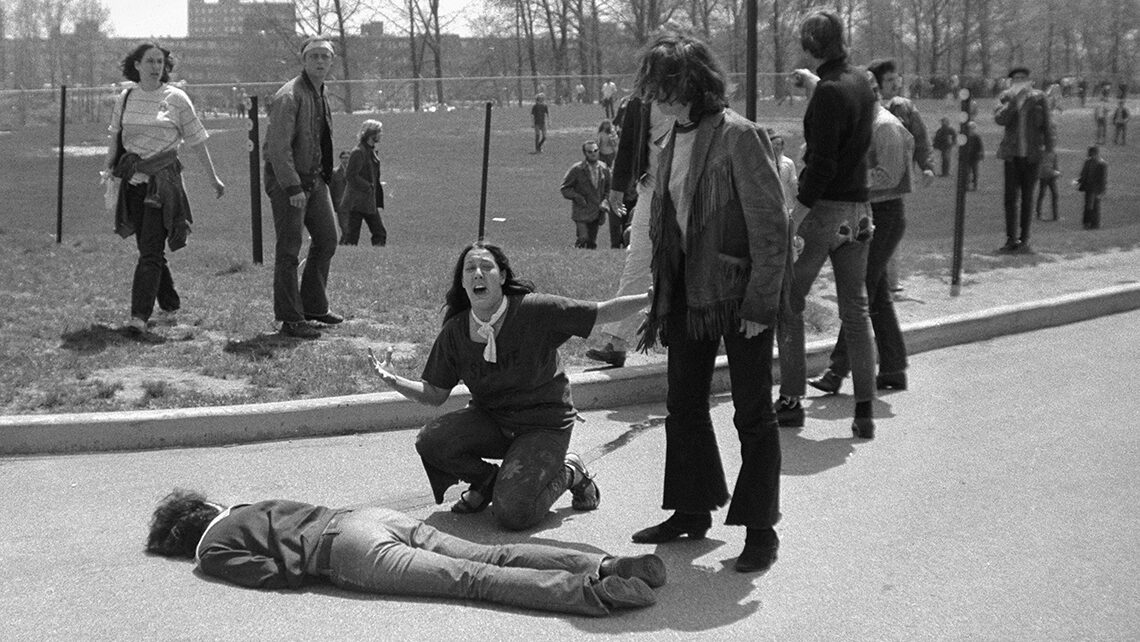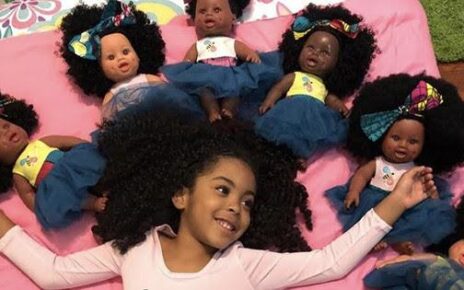Last May, when Mary Ann Vecchio watched the video of George Floyd’s dying moments, she felt herself plummet through time and space — to a day almost exactly 50 years earlier. On that afternoon in 1970, the world was just as riveted by an image that showed the life draining out of a young man on the ground, this one a black-and-white still photo. Mary Ann was at the center of that photo, her arms raised in anguish, begging for help.
That photo, of her kneeling over the body of Kent State University student Jeffrey Miller, is one of the most important images of the 20th century. Taken by student photographer John Filo, it captures Mary Ann’s raw grief and disbelief at the realization that the nation’s soldiers had just fired at its own children. The Kent State Pietà, as it’s sometimes called, is one of those rare photos that fundamentally changed the way we see ourselves and the world around us. Like the image of the solitary protester standing in front of a line of tanks in Tiananmen Square. Or the photo of Kim Phuc, the naked Vietnamese girl fleeing the napalm that has just incinerated her home. Or the image of Aylan Kurdi’s tiny, 3-year-old body facedown in the sand, he and his mother and brother having drowned while fleeing Syria.
These images shocked our collective conscience — and insisted that we look. But eventually we look away, unaware, or perhaps unwilling, to think about the suffering that went on long after the shutter has snapped — or of the cost to the human beings trapped inside those photos. “That picture hijacked my life,” says Mary Ann, now 65. “And 50 years later, I still haven’t really moved on.”
Mary Ann Vecchio has granted few interviews in 25 years, and as a child of the ’60s — with her own entanglement with the FBI — she’s still a bit wary. Partway through the first of what would go on to be a dozen interviews over the phone, she stops abruptly. “Are you doing this on your own?” she asks. I’m freelancing, I tell her. Is that what she means? No, she wants to know if I’m working with a political party. Or law enforcement. “When you’ve lived the life I have,” she says, “you still worry that maybe people are after you.” She also tells me she’s researched me before agreeing to speak. “I’m a little FBI-ish myself, in a renegade way,” she says. “And I’m also still that hippie kid who always sees a rainbow.”
Before Kent State, she says, she was a free spirit. “I was the kid rolling down the river on a raft,” she recalls. “I was magic. In my childhood, I believed anything was possible.” But her home in Opa-locka, Fla., not far from Miami International Airport, where her father was a carpenter, could be volatile. When her parents fought, she and her brothers and sisters would scatter, with Mary Ann hiding out in spots as far away as Miami Beach, some 15 miles from home. Soon she got in trouble — smoking pot, skipping school. So in February 1970, when the police told Mary Ann, then 14, that they’d throw her in jail if they caught her playing hooky one more time, she took off — in her bare feet. She says she wasn’t rebelling against her parents’ authority or seeking to join the antiwar movement: “I just wanted to be anywhere that wasn’t Opa-locka.”
Hitchhiking her way across the country, Mary Ann slept in fields, at hamburger shacks, at crash pads, working here and there for money for food, which she shared with other kids who were also bumming around. Seeing the country, meeting new people, sharing music and the occasional joint — the adventure had that feeling of magic from her childhood. Until, that is, she got to Kent State in northern Ohio, where, on May 4, student protests erupted over President Richard Nixon’s decision to invade Cambodia. Mary Ann, in her jeans, white scarf and a pair of hippie sandals someone had given her, headed toward a field where students were gathered. On her way to join the protest, she struck up a conversation with a guy in bell-bottoms. The two of them watched as another student waved a black flag, taunting the National Guard troops who had been sent in after protesters had burned down the ROTC building two nights before. The soldiers seemed to retreat to a nearby hill; then, in the next 13 seconds, they fired more than 60 shots.
Mary Ann dropped to the pavement and waited until the smoke had cleared to look up. Jeffrey Miller, the student she’d been talking to, was facedown on the ground; he’d been shot through the mouth. She knelt over his body as blood seeped onto the pavement. Other students walked by, too stunned or confused to look. “Doesn’t anyone see what just happened here?” she remembers crying. “Why is no one helping him?” As the soldiers approached, their guns at the ready, she recalls asking them a question that countless others across the country would soon ask as well: “Why did you do this?”
Nearby were more bodies. Allison Krause was shot in the chest; William Schroeder in the back. Sandy Scheuer, who was just passing through the area on her way to class, was struck by a bullet that hit her jugular vein. Four dead in Ohio.
John Filo was a senior at Kent State in May 1970, a student photographer who almost missed out on covering the protests because he’d been in the woods taking pictures of teaberry leaves for his senior thesis that weekend. All the other photographers on the student paper had assignments from out-of-town papers, so John, 21, was working in the newspaper office to help process their pictures. On his lunch break, he grabbed a camera and stepped outside. He went straight toward the action, where a student in the no man’s land between soldiers and students waved a black flag. John snapped a photo thinking, “Okay, I’ve got my picture.” A moment later, the soldiers formed a rifle line. “I put my camera to my eye and trained it on one of the soldiers,” he says. “He aimed toward me, and then his gun goes off. The next thing I know, a bullet hits a tree next to me and a chunk of bark flew off.”
John dropped to the ground and waited out the 13 seconds of gunfire. When the smoke cleared, he stood and patted his arms and legs, checking to see if he’d been hit. “It was like slow motion. I just kept wondering, ‘How come I’m not shot?’ ” Then, not 10 feet away, he saw a body on the ground. John was running out of film as he saw a girl kneel beside the body. “I knew the boy was dead, but I could tell she didn’t know,” he told me. “I could see something building in her, and all of a sudden she lets out this scream and I shoot. I shoot one more picture, and I’m out of film.” By the time he had reloaded his camera, the girl was gone.
John remembers the soldiers ordering students who were lingering at the scene to disperse — “or they’d shoot again.” A few moments later, soldiers using bullhorns announced that the university was closed. “They ordered everyone to go home.”
Mary Ann just remembers running. She didn’t know anyone at Kent State; she’d known Miller for only 25 minutes. But she saw National Guard troops herding students onto buses, so she followed in a daze. Some two hours later, when the bus arrived in Columbus, the soldiers told everyone to get off. Many of the students ran to waiting parents. Mary Ann stumbled around the streets of the city; she’d never even heard of Columbus.
Back on campus, students were yelling at John, calling him a pig, a vulture. John yelled back. “No one’s going to believe this happened,” he told them. “This,” he said, pointing to his camera, “is proof.” When he saw Guard troops cutting down electric lines, John ran to his car. After hiding the film inside a hubcap, he drove two hours to the office of his hometown newspaper in western Pennsylvania to process his film. As he watched the film develop, he knew he had something the world needed to see.
When he called the Associated Press from the newsroom of the Valley Daily News of Tarentum, he was told the news service had plenty of Kent State photos coming in from its bureau in Akron, Ohio, and that its entire wire capacity was being used to transmit those photos. But when there was an unexpected break in the transmissions from Akron, John jumped on the wire and sent his photo. His image of the grieving girl ran on the front pages of newspapers all over the world the next day. The caption identified her simply as a “coed.”







